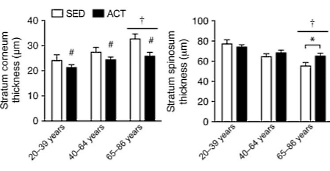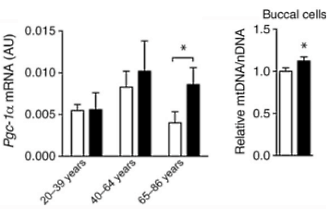|
Definition: "An ergogenic aid is any substance or phenomenon that enhances performance "
|
|
||||||||
18.04.2017 |
|
|
Lazy bones who takes up exercise rejuvenates skin
Many of the wonderful things that exercise does for the muscles can also be seen to happen in the skin. And probably in other parts of the body too. Active muscles release the hormone interleukin-15 into the bloodstream and that hormone rejuvenates the cells in the skin. And in other tissues too. Canadian sports scientists at McMaster University write about this in Aging Cell.
Study
Results
The researchers also studied cells taken from the participants' mouths. In those who were physically active the gene for PGC-1-alpha was more active. PGC-1-alpha is activated by physical exercise and induces cells to produce more mitochondria. That also happens apparently in other cell types.
And indeed, in the cells from the mouths [Buccal cells] of the active participants the researchers found more mitochondrial DNA [mtDNA].
[Ask Google: what does one one the best websites on ergogenic strategies has to say about the relationship between aging and mitochondria?]
The researchers also got some of their inactive over-65s to exercise for a period of three months. They had to do a 45-minute cardio session twice a week. During that period the outer layer of dry skin became thinner and the amount of collagen and the number of mitochondria in the deeper skin layers increased.
Mechanism
We already knew that physical exercise, via interleukine-15, not only keeps muscles young and strong [Cell Biol Int. 2003;27(10):845-51.] [Exp Cell Res. 2002 Oct 15;280(1):55-63.] [Biochem Biophys Res Commun. 1997 Oct 9;239(1):6-10.], but also has positive effects elsewhere in the body. For example, interleukine-15 plays a role in activating natural killer cells, the immune cells that clear up derailed cells and pathogens. [Nat Rev Immunol. 2006 Aug;6(8):595-601.]
Source:
More:
Archives:
|
|
|||||||||||||||









